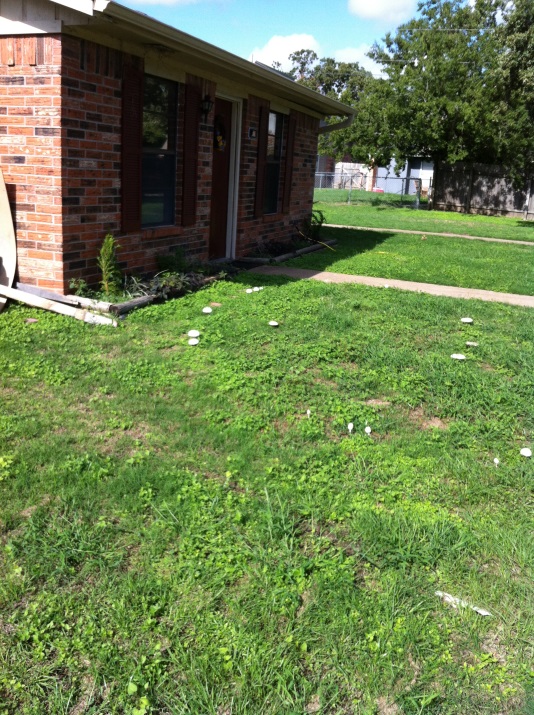This is another assignment submitted by BESC484 student, B. Commer, as a partial requirement for the course. This was a situation that was pretty rampant 1-2 weeks ago after the rain we got in many parts of Texas. Some of these mushroom are still present. Enjoy- KO
Are mushroom rings invading you yard?

Over fifty different species of fungi have a unique characteristic of creating circular patches of mycelium lined with fruiting bodies on the outer edge. Grasses and turfs are most susceptible to these mushroom “fairy rings” and will usually begin to show symptoms within a few days of a heavy rainstorm. They are named after an old folk tale that theorized the mushrooms were proof that fairies had danced in a circle the night before, leaving fairy dust in their trails.
We now know that the mycelial branching begins with a single spore or piece of hyphae and continues outward in each direction, consuming the nutrients on the leading front as it spreads. There are three general types of fairy rings, the first of which will actually make the soil hydrophobic enough to repel water, leaving a dead brown circle where the edge of the mycelium reaches. As the inner core of mycelia is malnourished it disintegrates, allowing the grass or turf to replenish in those areas (hence why it is only a brown ring and not a complete dead patch). Type 1 is more common in warm, dry locations and croplands, while the second type of fairy ring will create a lush, dark green inner circle of grass or turf that grows much faster than the surrounding vegetation (See Fig. 1).  The final type does not produce symptoms within the vegetation aside from the arch or full circle of mushrooms, and is the most commonly seen in lawns (Fig. 2). Treating can be difficult, since removing the symptomatic fungus does not eradicate the entire underground mycelium as well. Fungicides are unsuccessful at penetrating the thick mycelial layer, especially in the first type of fairy ring since the roots are practically waterproof. The living edge will continue to grow up to 8 inches a year in diameter, but the symptoms will most likely be suppressed during periods of unfavorable weather and drought. For more information on control measures, see the Agrilife Extension factsheet at http://aggie-horticulture.tamu.edu/archives/parsons/turf/publications/fairyrings.html
The final type does not produce symptoms within the vegetation aside from the arch or full circle of mushrooms, and is the most commonly seen in lawns (Fig. 2). Treating can be difficult, since removing the symptomatic fungus does not eradicate the entire underground mycelium as well. Fungicides are unsuccessful at penetrating the thick mycelial layer, especially in the first type of fairy ring since the roots are practically waterproof. The living edge will continue to grow up to 8 inches a year in diameter, but the symptoms will most likely be suppressed during periods of unfavorable weather and drought. For more information on control measures, see the Agrilife Extension factsheet at http://aggie-horticulture.tamu.edu/archives/parsons/turf/publications/fairyrings.html


